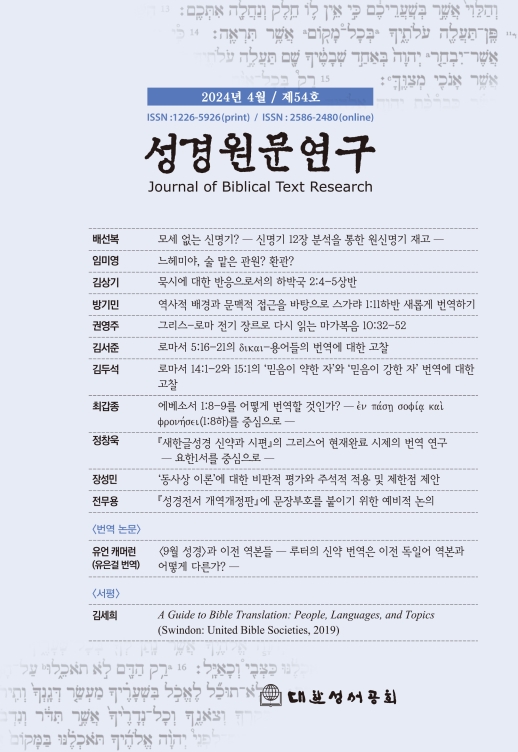The purpose of this study is to contribute to the ongoing debate by critically assessing some of the remarkable advances in the study of ancient Greek that have been made over the past thirty years or so, and to suggest some applications and limitations to the study of the New Testament. First, I present the following consensus among scholars in the debate based on a retrospective assessment by B. M. Fanning. (1) Verbal aspect is key to understanding the verbal meaning of ancient Greek verbs. 2) Aspect is a matter of viewpoint, i.e., the perspective from which the speaker views an action or state of affairs, and is a semantically distinct category from procedural or actional characteristics, commonly referred to as Aktionsarten or kinds of action. 3) The Greek aorist is the perfective aspect, while the present and imperfect are the imperfective aspect. 4) Greek verb forms play an important role in the organization of certain kinds of discourse. I then critically evaluate each of these items, and suggest some points to note the exegetical use of the Verbal Aspect Theory as follows. First, one should not overstate the aspectual value of a tense form during exegesis of its meaning. The aspectual value of a tense form is not, by itself, sufficient to support any particular exegetical claim. Rather than basing an argument on an aspectual value only, it should therefore be supplemented by a variety of other evidences, including context, narrative logic, lexical meaning, usage, and the author's theology. Second, it is quite natural to attempt to read the conscious choices or literary intentions of the speaker/author into the text reading process, given that certain verbal aspects represent a difference in the speaker’s/author’s point of view, but this too requires very careful exegetical verification. In this process, it is important to closely examine whether certain tense forms in the text are out of the ordinary. Third, it seems unnecessary to try to implement aspectual values in Korean translations. Although aspectual values are encoded in tense forms, they actually express tense values and Aktionsarten in combination with other contextual factors, which can be translated quite well into Korean. Finally, the process of analyzing texts based on differences in speaker/author perspectives also requires a somewhat conservative approach. This is where we need to exercise exegetical care and balance while suppressing hermeneutical impatience. In conclusion, I believe that if we pay attention to these points, we can make exegetical use of the various insights brought about by the Verbal Aspect Theory, and thus offer creative and novel perspectives that have not been available for previous studies.
이 연구의 목적은 지난 30여 년간 고대 그리스어 연구에서 이루어진 주목할 만한 몇몇 발전들을 비판적으로 평가하고, 신약 연구에 대한 몇 가지 적용점과 한계점을 제시함으로써 현재 진행 중인 논쟁에 기여하는 데 있다. 먼저, B. M. 패닝(Fanning)의 회고적 평가를 바탕으로 학자들 사이에서 형성된 다음과 같은 합의점들을 제시한다. (1) 동사상(Verbal aspect)은 고대 그리스어 동사의 의미를 이해하는 데 핵심적이다. (2) 상(aspect)은 화자가 어떤 행위나 상황을 바라보는 관점(viewpoint)의 문제이며, 흔히 동작류(Aktionsarten)나 행위 종류(kinds of action)로 불리는 과정적 또는 행위적 특성과는 의미론적으로 구별되는 범주이다. (3) 그리스어의 아오리스트(aorist)는 완료상(perfective aspect)이며, 현재(present)와 미완료(imperfect)는 비완료상(imperfective aspect)이다. (4) 그리스어 동사 형태는 특정 종류의 담화(discourse)를 조직하는 데 중요한 역할을 한다. 다음으로, 나는 이 항목들을 각각 비판적으로 평가하고, 동사상 이론의 주석적 활용을 위해 유의해야 할 점들을 다음과 같이 제안한다. 첫째, 시제 형태의 의미를 주석할 때 그 상적 가치를 과대평가해서는 안 된다. 시제 형태의 상적 가치만으로는 특정 주석적 주장을 뒷받침하기에 충분하지 않다. 따라서 단지 상적 가치에만 근거하여 논증하기보다는 문맥, 서사 논리, 어휘적 의미, 용법, 저자의 신학 등 다양한 다른 증거들로 보완해야 한다. 둘째, 특정 동사상이 화자/저자의 관점 차이를 나타낸다는 점에서, 화자/저자의 의식적인 선택이나 문학적 의도를 텍스트 독해 과정에 읽어내려는 시도는 지극히 자연스럽지만, 이 역시 매우 신중한 주석적 검증을 필요로 한다. 이 과정에서 텍스트에 나타난 특정 시제 형태가 통상적인 용법에서 벗어난 것인지 면밀히 살펴보는 것이 중요하다. 셋째, 상적 가치를 한국어 번역에 굳이 구현하려고 애쓸 필요는 없어 보인다. 상적 가치는 시제 형태에 담겨 있지만, 실제로는 다른 문맥적 요인들과 결합하여 시제적 가치와 동작류를 표현하며, 이는 한국어로도 충분히 잘 번역될 수 있다. 마지막으로, 화자/저자의 관점 차이에 근거하여 텍스트를 분석하는 과정 역시 다소 보수적인 접근이 필요하다. 이 지점에서 우리는 해석학적 조급함을 누르면서 주석적 신중함과 균형 감각을 발휘해야 한다. 결론적으로, 이러한 점들에 유의한다면 동사상 이론이 가져온 다양한 통찰들을 주석적으로 활용할 수 있으며, 이를 통해 기존 연구에서는 얻을 수 없었던 창의적이고 새로운 관점을 제공할 수 있다고 믿는다.






